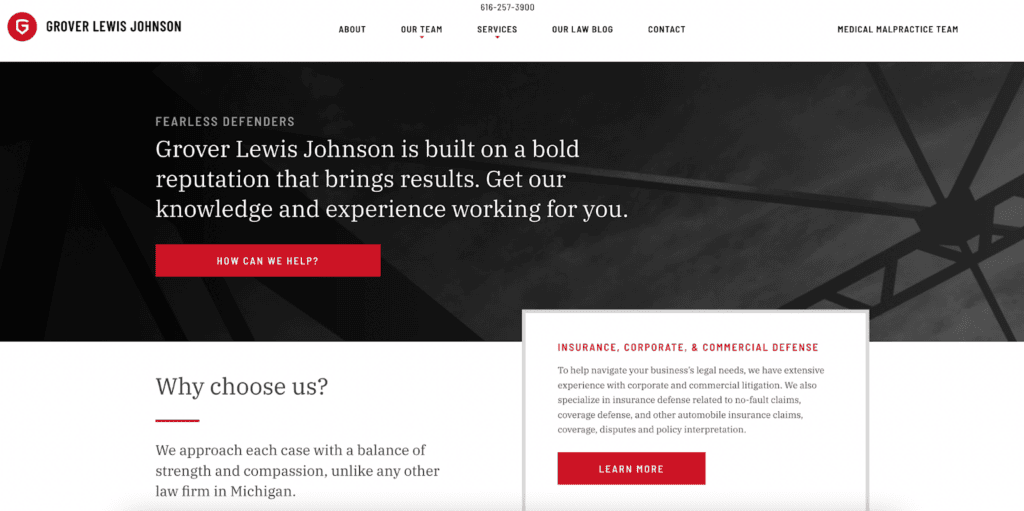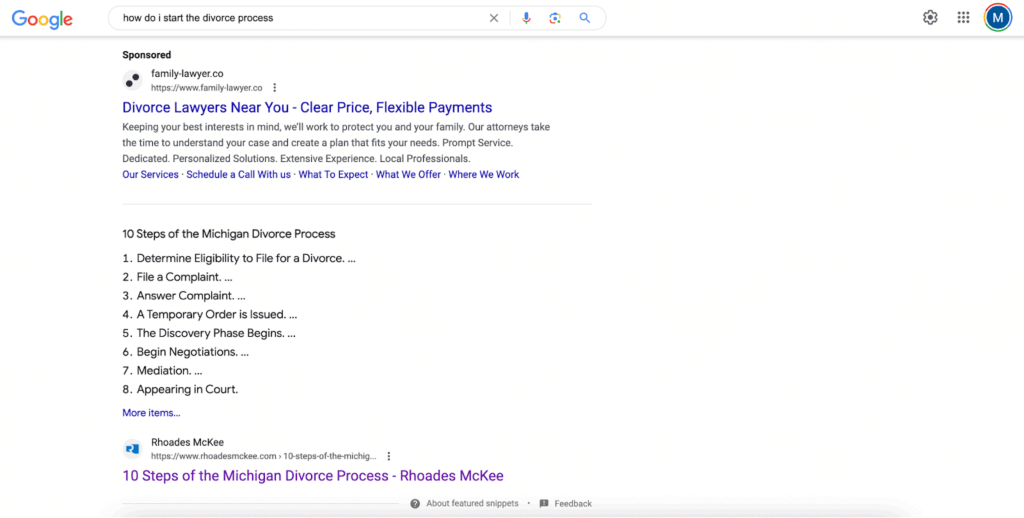As an attorney, you may not recognize the wealth of information you have that the general public does not.
Common legal issues and processes that are part of your everyday life may be a complete mystery to those who need your services.
This is where legal content marketing comes in.
Right now, your future clients are searching the web for information about everything from what to do following a car accident to how to file a divorce or the process for writing a will.
You have the answers to these questions, but how do you reach the people who need to see them most?
In our complete content marketing guide for law firms, we will outline the entire process for building or revamping your content marketing strategy, from understanding who you’re targeting to measuring results.
See how Kaleidico can help you reach lead generation goals and get the best cases.
What is content marketing for law firms?
Specific content marketing goals are unique to each law firm.
But the general purpose of content marketing is to strategically create and distribute valuable, informative, and engaging content to attract clients and build an online presence.
Other content marketing goals for law firms include:
- Establishing trust and credibility with the target audience through high-quality content
- Generating new leads and nurturing them until they are ready to convert
- Educating the target audience about legal topics and common questions
- Establishing thought leadership by consistently posting thoughtful, insightful, and well-researched content
- Increasing brand visibility by improving search engine rankings
Content marketing primarily focuses on organic, non-paid content creation and distribution.
While it can include content for paid advertisements, unlike paid ads, content marketing is meant to live for many years on your platforms and continue generating leads.
Content marketing is paired with search engine optimization (SEO) to achieve this long life.
What is SEO for law firms?
SEO for law firms involves optimizing your law firm’s website and content to improve your ranking and visibility on search engine results pages (SERPs) such as Google.
SEO strategies for law firms include:
- Keyword research to identify search terms your clients use to find your services
- Creating high-quality content that matches a potential client’s search intent and includes relevant keywords
- Optimizing all pages on your website to include keywords in headers, descriptions, and titles
- Including backlinks to reputable websites in your content
- Creating location-specific content to optimize for local search
- Ensuring the experience on your website is fast, clean, bold, and user-friendly
Creating content and optimizing it may seem like two separate jobs. Once you start creating, however, you can start automatically optimizing all future content to perform at its best.
Legal content marketing includes many types of content, including videos, blog posts, infographics, ebooks, emails, and more.
How can content marketing help lawyers generate more case leads?
Content marketing and SEO are an unbeatable combination that will give your content more visibility online via search.
But content visibility is one thing — once you have their attention, will they stay?
Here’s how your content can actually generate case leads through multiple avenues:
- Writing high-quality content that matches a potential client’s search intent will establish trust and build credibility
- Including strategic calls-to-action (CTAs) within your high-quality content allows you to capture a lead’s contact information
- Sharing your content on relevant social media platforms will help you reach your audience, encourage engagement, and capture lead information
- Your social media followers will share your engaging, valuable content on their individual pages to widen your audience
- Increased visibility and referrals will lead to more case leads
You always have to keep in mind where your content fits into your larger marketing strategy, including where your potential clients are at in their customer journey and what they need at each step to be encouraged to reach out.
The ultimate goal is to educate and empower your potential clients—through your content—to take the next steps. This is how you get more qualified case leads.
How to build a content marketing strategy for your law firm
Now that you know the pieces contributing to successful content marketing and how they can generate more case leads for your law firm, we can dig into the article’s meat.
What do you need to do to build that unbeatable content marketing strategy?
As with any strategy or campaign, we must first understand who you’re targeting. This will guide the rest of your strategy.
Understand who you’re targeting
Each piece of content will have specific goals depending on who you’re trying to target.
The best way to segment your audience is with client personas, which are fictional or semi-fictional “characters” based on actual clients.
They include the following detailed information about a client:
- Demographic information such as age, gender, occupation, income, education, etc.
- Specific legal needs and challenges
- Goals and motivations for seeking legal assistance
- Values, beliefs, and interests
- Preferred methods of communication
- Key factors in their decision-making process
- Social media behaviors and how they use your website
While client personas are detailed and specific, this doesn’t mean you need thousands of them. Instead, start with two to five personas so you’re not overwhelmed with content creation.
For example, if you’re a family lawyer, you may have a client persona for clients who are getting a divorce or families who are looking to adopt a child.
Client personas allow you to craft specific content tailored to these audiences.
What if I don’t know much about my audience yet?
Even experienced attorneys would benefit from conducting market research or client surveys to learn about the specific goals and challenges of their target audiences.
Additionally, speak to your customer-facing employees and look at your competitors’ social media pages to gather more demographic information.
If you’re a new attorney still learning about your target audiences, fill in what you know and expand over time.
Client personas are meant to be re-evaluated occasionally to reflect changes in your practice or even societal changes. Consider how the COVID-19 pandemic could have majorly shifted some client personas.
Determine your goals
Earlier, I laid out some of the most common general content marketing goals, including establishing trust with your audience, educating them, and generating new leads.
What specific goals do you want for your content marketing based on your practice length, practice areas, and client personas?
Specific legal content marketing goals might include:
- Establishing each attorney at your firm as a thought leader
- Using video to generate more workplace discrimination leads
- Educating divorce clients about the process
- Boosting client engagement on Facebook
- Driving medical malpractice leads to the landing pages on your website
- Increasing your number of consultations
While your client personas guide your content goals, your content goals will determine your specific topics and channels.
One of the best ways to use new AI technology, such as ChatGPT, is to request a list of topics for your particular goals.
For example, I asked ChatGPT to come up with a list of blog topics for a personal injury lawyer, and these were some of the results:
- “What to Do After a Car Accident: A Step-by-Step Guide”
- “Understanding the Different Types of Personal Injury Claims”
- “The Importance of Seeking Medical Attention After an Accident”
- “Common Mistakes to Avoid in Personal Injury Cases”
- “How to Determine Fault in a Personal Injury Case”
- “The Role of Insurance Companies in Personal Injury Claims”
Chatbots are helpful brainstorming tools
While there is a lot of controversy and debate surrounding AI right now due to global calls for regulation, the tools we have available to us right now aren’t too far off from the digital tools and machine learning we already have at our disposal.
That being said, we each have a responsibility to understand the limitations of these tools, including the potential for inaccuracies and outdated information.
If you use chatbots for anything other than brainstorming, be sure to add your own personal touch to anything they create — and fact-check all statements.
Get a website or refresh your current one
In the next section, we are going to talk about what you need to know to optimize your current and future website content.
But first, we need to discuss whether you currently have a website and, if you do, whether it’s ready to generate new leads.
You likely already have a website you use for your law firm or practice; in this case, you will need to optimize the existing content.
But you need to get one if you don’t have a website.
We like to describe a website for law firms as your digital office space. When visitors land on your home page, what do you want them to feel? What is the first impression you want to give?
Take a look at Grover Lewis Johnson’s homepage below. What is the impression you get? What stands out to you? Does the bold photo match the positioning statement?

You can’t go far with your content marketing strategy without a website. Your future leads don’t have anywhere to go. Sure, you could include a phone number on social media or email, but what other sorts of content are you creating without a website?
Law firms looking to revamp their content strategy often discover that their website needs a complete redesign because it is outdated, slow, and unusable.
Starting fresh is best if your current design and layout no longer match who you are today. You then have full control over all aspects of your website and can craft and optimize your content simultaneously.
It’s easy enough these days to create your website using Wix or WordPress but to let your ideas soar; it’s best to collaborate with a digital marketing agency or hire a web developer you can work with one-on-one.
Learn how Kaleidico can help you reach lead generation goals with a new website.
Now, let’s talk about optimizing your website content.
Learn what it takes to optimize your content
Optimizing your content involves many layers, including content you already have on your website, content you plan to create, and content for each platform.
But regardless of whether you’re beginning with existing or new content, start with keyword research to identify your potential clients’ search terms.
Keyword research is complex and competitive, so it’s best to collaborate with an experienced content marketing agency to help you achieve your goals.
However, if that’s not in the cards for you right now, try out Google’s Keyword Planner tool or simply perform searches for your competitors’ top-performing content and note which keywords they use.
Let’s look at what optimization includes for each of your layers of content.
Existing content
Existing content includes any written content on your current website, such as your mission statement, “about” information, landing pages for each service, and blog content.
To optimize your existing content, create a strategy for reviewing each page and evaluating the content quality, user experience, and keywords.
If your existing copy lacks relevant keywords, plan to rewrite it on your website to naturally include keywords in titles, headings, and descriptions.
Your plan can be as simple as putting the links to the pages you need rewritten in a spreadsheet and tracking when it is completed and republished.
Optimizing your content also means updating any copy that may still be relevant or performing well but has outdated information.
For example, this article is a rewrite of a previous post on Kaleidico that needed new information to bring it up to speed in 2023.
Your existing content includes updating videos, photos, or lead magnets that may no longer fit your services or audience.
Future content
From now on, all your future content can be optimized to include relevant keywords, up-to-date information, and backlinks to reputable websites.
Rapid changes are occurring in the current landscape, no matter your industry. Eventually, it can become difficult to keep up with which articles need updating and which content is no longer relevant.
Fortunately, there are website auditing tools available today to help you monitor your website and keep it fresh.
The following SEO tools are the most popular among marketers today:
- SE Ranking
- Semrush
- Ahrefs
- Screaming Frog
- Google Analytics
Audit tools help you track how your website is performing and where you need to improve.
Content across platforms
SEO is focused on search engines, while social media optimization (SMO) is focused on creating content for your social media platforms that draws your followers to your website.
Much like SEO, your SMO strategy includes relevant keywords and a balance of informative, engaging, and entertaining content tailored to the appropriate target audience.
First, you’ll determine which platforms your audience uses the most and establish a consistent posting schedule on those platforms.
Top social platforms in 2023 include:
- YouTube
- TikTok
Then, you’ll develop a plan for monitoring and responding to comments, direct messages, and discussions.
SMO also involves the use of trending, industry-specific, or location-based hashtags to help your audience find your content.
Brainstorm and experiment with content types
You know your target audience and goals. What types of content do they want to see?
Sometimes, it takes some trial and error to discover what your audience will engage with the most.
You can determine their preferences in a few simple ways:
- Survey your audience to determine the types of information and content they are seeking
- Use their most frequently asked questions as a guide for your content
- Just start creating content and measure the level of engagement on each post through the platform tools
You can create a seemingly endless amount of content for your audience. Let’s look at some of the most popular types of content for law firms.
Video
Video is continuing to grow in popularity across channels, industries, and audiences.
If a picture is worth 1,000 words, a video must be worth millions. Studies have shown that not only do consumers prefer videos, but they retain more information from videos than text.
Attorneys can use video to explain complex legal topics, walk their potential clients through a specific legal process, or discuss frequently asked questions.
Take a look at the YouTube video below from an attorney answering the question, “Why do most personal injury cases settle?”
Video helps you position yourself as a trusted authority on a topic, and your friendly, approachable demeanor will reveal to those seeking legal help that you are a safe person who is there to help them.
Remember, the goal with content is to empower your audience to feel comfortable and confident enough to reach out. Videos can help you easily accomplish this feat.
With today’s smartphone video quality, you can simply prop up your phone in a well-lit area and hit “record.”
Blog posts
Blogs are true lead generation machines.
Combined with relevant keywords and other SEO strategies, your blog content has the potential to rank on Google without any advertising involved.
For example, I searched “How do I start the divorce process” on Google.
The first two results were paid posts labeled “Sponsored,” but the third result was a “featured snippet” from an attorney’s blog post.

Keyword research will help you compete for the top spots and indicate which terms are worth your while.
Similarly to video, use frequently asked questions as a starting point for your blog content, and brainstorm with your team which other topics are worth addressing.
Competitor research is also helpful for determining which topics are ranking and how your competition is handling a certain topic.
Of course, you’re not going to “steal” their topics — you’ll get ideas for other topics and keywords you can use.
Infographics
Infographics are a reliable form of law firm content marketing that allows attorneys to share information in a concise, aesthetically pleasing way.
According to Digital Information World, infographics are 30 times more likely to be read in their entirety than blog posts or news articles.
They are easily shareable on social media and perfect for plugging into blog posts or incorporating into videos.
You don’t have to be a graphic designer to create infographics. Many marketers use free tools such as Canva.
Podcasts
Data from 2023 revealed that 42% of Americans 12 and older have listened to a podcast in the past month.
Many legal podcasts, such as Legal Marketing 2.0 Podcast, are targeted at other legal professionals.
If your target audience listens to podcasts and you enjoy explaining information in this format, you can fulfill a need for your audience by launching a legal podcast aimed at those who need your services.
Podcasts are a great format for hosting guests or for influencer partnerships.
You can also film your podcast and post it on YouTube.
Lead magnets
Legal guides or other long-form content, such as ebooks, case studies, or whitepapers, are excellent content for lead magnets.
A lead magnet is a valuable resource or incentive offered by a business, including law firms, in exchange for contact information and permission to contact the prospect.
It is designed to attract potential clients and generate leads by providing something of value that addresses a specific problem or fulfills a need for the target audience.
Lead magnets are strategically placed throughout a website. They also are posted on social media or shared in an email.

This example was taken from Kaleidico’s website. We offer a free guide to designing consumer-direct websites in exchange for the visitor’s name and email address.
Once the visitor offers their email address or phone number in exchange for your content, you now have their contact information and can continue nurturing the lead until they are ready to work with you.
The key to an effective lead magnet is to ensure it aligns with the target audience’s needs and offers a solution or valuable information related to their specific legal concerns.
It should be easily consumable, engaging, and provide a clear benefit to the prospect.
No content marketing strategy for law firms is complete without email.
Once you’ve built an email list with your lead magnets and other website and social media opt-in forms, you can start executing your email campaigns.
First, it’s important to segment your email list based on various criteria, such as client type, practice area of interest, or stage in the client journey.
Email content keeps your leads engaged and helps you stay top-of-mind.
Create the following types of email content to nurture your client relationships and drive engagement:
- Newsletters filled with industry news, legal developments, recent cases, or firm achievements
- Email updates
- Educational content, including blog posts, articles, guides, or videos
- Invitations to upcoming webinars or workshops
- Promote your lead magnets
- Share case studies or client testimonials
Your emails should contain clear CTAs to encourage your recipients to take the desired action.
Make use of the automation tools in your email marketing software (such as MailChimp) to send out emails based on certain lead “triggers” or personalized content for birthdays and holidays.
Email marketing software also contains analytics tools so you can measure open rates, click-through rates, and conversions.
Create a content calendar
We’ve discussed several types of content across multiple platforms.
You’ll need to create a content calendar to keep track of each goal, strategy, and campaign.
Your content calendar can be as simple or robust as you need, or use project management software to juggle multiple content projects and campaigns.
Monday.com, ClickUp, and Basecamp are three popular platforms for managing content projects.
Create and optimize your website landing pages
A simple law firm website is better than no website at all, but you can offer your current and future clients so much more by adding relevant landing pages.
In the previous screenshot we shared from Grover Lewis Johnson, the firm has the following landing pages:
- About page detailing their mission and core values
- Team pages for attorneys and support staff
- Landing page for each service they offer
- Blog page
- Contact page
Each landing page on your website offers ample SEO opportunities through keywords, educational content, web forms, lead magnets, and more.
Your website can be an ultimate resource for those seeking legal services and draw in eyes from all over the web.
For example, individual attorney profile pages can be naturally packed with keywords, and assist with local SEO opportunities as well.
When someone searches for an attorney’s name, they will find a detailed resource that includes everything they would need to know about the person. That includes their credentials, case successes, background, reviews, and more.
And because it’s all located within your firm website, the visitor has easy access to all your services and information on how the process works, plus clear CTAs to move them to the next steps.
Choose your channels
Where is your audience hanging out?
Remember, it’s always more about quantity than quality when it comes to content marketing.
Choose a few main channels that your audience loves, and build a strategy for each channel.
For example, Facebook, YouTube, and LinkedIn are excellent platforms for law firms and attorneys. Consider posting a piece of content once a day on Facebook and LinkedIn, and once a week on YouTube.
The beauty of content marketing is that your content can continually be reused and repurposed. A YouTube video can turn into three blog posts. A LinkedIn post can become a YouTube video series, etc. And there will be no shortage of ways you can “spin-off” one topic into another.
In addition to your website and social media channels, there are plenty of other online spaces that can help boost your law firm’s visibility online, including the following.
Online directories
Online directories are essentially today’s yellow pages with a digital twist — and no tight space requirements.
The most popular online legal directories include:
- Lawyers.com
- FindLaw
- Nolo
- LegalZoom
Online legal directories generally allow lawyers to upload a photo, write a biography, and display contact information. They also often allow previous clients to leave a review.
Some directories, such as Nolo, allow you to publish articles on your profile and include other helpful resources.
Filling out an online legal directory completely will help you rank on search engines, and particularly help with local SEO.
Google Business Profile
Speaking of local SEO, one of the simplest but most powerful marketing moves you can make is to create a Google Business Profile, fill it out fully and completely, and routinely update it.
That includes contact information, hours, photos, reviews, service options, and other relevant details.
A complete Google Business Profile will help you show up as No. 1 when someone searches for “family lawyers near me.”
Measure your results and use them to improve
Even if you’re not using the most robust automation and analytics tools at your disposal, there’s really nothing stopping you from doing some sort of measuring and reporting to define your key performance indicators (KPIs).
For social media, this looks like tracking the number of “likes” and comments on a post, or the number of views on a video. For email, it means tracking your open rate and click-through rate.
Eventually, you can build up to using sophisticated analytics tools and platforms that can help you zero in on exactly what’s working and what’s lacking.
Of course, all this data exists to help you continue doing what works and improve upon what doesn’t.
Refining your marketing strategies involves adjusting your target audience, continuing to optimize your content, or moving your efforts to more effective channels.
Don’t forget the legal marketing rules
Have you ever heard that lawyers can’t advertise?
In the past, attorneys had strict advertising rules that led to many believing that advertising was not worth the hassle.
Fortunately, law firm advertising, including content marketing, is considered an essential part of legal practice today — but there are still certain rules to keep in mind.
Law firm advertising rules include:
- Avoiding the word “expert” or “specialist”
- Not deceiving or misleading the public with false claims about your services or past cases
- Explicit permission for using someone’s picture or endorsement
- No direct solicitation
Make sure you take a look at American Bar Association Rules 7.2 and 7.3, and read our guide on the must-know attorney advertising rules.
In general, the ABA rules are wholesome reminders to uphold the dignity of the legal profession through advertising practices and attempts to help educate the community about the resources and services available to them.
Get Our 90-Day Law Firm Marketing Plan
Work with Kaleidico to build an unbeatable content strategy for your law firm
Ready to dive into your new and improved legal content marketing strategy?
Kaleidico has more than two decades of experience in helping law firms thrive.
We have helped a range of law firms attract clients, with a particular focus on those specializing in personal injury and medical malpractice.
With our industry knowledge and a comprehensive range of proven digital marketing services, we provide an entire lead generation program to attract more qualified leads and grow your business.
Our law firm marketing services include SEO and SEM, web design and development, content marketing, email marketing, social media, and more.
Get started today with a free discovery and strategy session.

